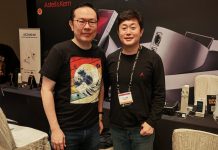
Campfire Audio is a small team of audio lovers based in Portland, Oregon. Since 2015, they have crafted unique earphones that sound amazing and bring you closer to your music. During the CamJam Singapore 2025, they launched two new earphones, the entry-level single-driver Axion and the five-driver Alien Brain.
NXT spoke with the founder lead acoustic engineer, Ken Ball, to learn more about the new products and the company philosophy.
Tell us more about the new Axion earphones.
The Axion is unique in a couple of ways. First, we use a new full-range driver called SDD – Silicon Dynamic Driver, which uses a silicon chip as the voice coil. It is similar to micro-planar drivers, and the diaphragm is flat with very fast transients.

Second, the cable is detachable and connects to USB-C, which has its high-res 32-bit 384kHz DAC. It is designed to be convenient for mobile users with three-button in-line control and a microphone, so it is easy to take calls and listen to music.
Please talk about your other new earphones, Alien Brain.
The Alien Brain is a five-driver hybrid design, consisting of an all-new full-range 10mm glass-PU driver, two mid-frequency dedicated balanced armatures, and two high-frequency BA drivers. We have made a lot of advancements in hybrid designs, so the Alien Brain builds on that. It’s an interesting model because the new glass-dome dual Neodymium magnet dynamic driver is very strong. The shell is 3d printed with the alien brain dome design in a black PVD full CNC stainless steel shell. It comes with 3.5mm and 4.4mm cables, and we will also bundle the USB-C DAC dongle.

Building on over a decade of earphone design and engineering, we expanded the legacy and boundaries of what is possible in a dynamic-BA hybrid, with the all-new, five-driver AlienBrain. With this model, I have focused on a modified Harman Curve design and added a range of our in-house features that we have learned over the years.
The price performance of the new Alien Brain was one of our main goals here.
What makes your brand different from others?
We are different from many other earphone brands in that we design, engineer, and acoustically tune all our products. We do everything in-house. I even do product photography and maintain the website.
Another uniqueness is that we have our engineering team with years of experience. I began experimenting with different components and buying branded headphones, which I would tear apart, rewire, and retune.
Our philosophy is trying to tune our earphones through this engineering concept called phase harmony, where we match drivers that work well with one another instead of forcing drivers to do what they could not handle. Through iterative engineering – experimenting with different drivers, sound tunings – we will achieve a product that is unique and different.
We spend eight months to a year tuning our products. Some don’t even make it to final production! What we try to do is create something unique and special for everyone, so I’m not trying to make an earphone that pleases everyone, but for certain people. And the idea is to try to find something that works for you.
What kind of sound tuning can we expect from Campfire Audio earphones?
It varies depending on the driver technology. I’m all about sourcing the best drivers and then combining multiple drivers so that there is synergy, and it gives you something unique and different that caters for different people.
As the lead acoustic engineer, I like to try to find something that is very layered and transparent. We aim to achieve good resolution and depth, defined highs and lows, and so the dynamic range is as wide as I can get, with a sound that is unveiled and very transparent. As part of our design philosophy, we try to be simple in the components. There are not a lot of resistors or capacitors to alter the drivers. I want to let the drivers run free and work well together to give you a very layered texture, a lot of separation, and imaging.

Do you have plans to develop over-ear headphones?
We did do one headphone and it was a really great success. The problem is, I have to work with another company because we don’t make the parts and so it’s a little bit harder to have control over the components when working with the company. I do love headphones and want to make them in the future, but I want to find the right partner with synergy, and when I do, we’ll start making headphones.








